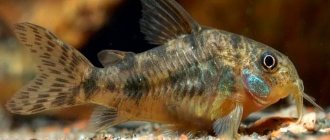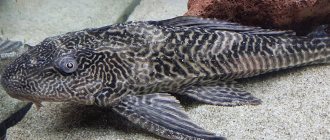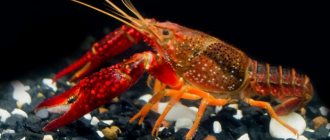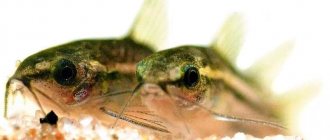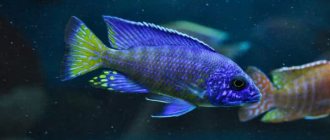The origins of Polypterus date back to the Cretaceous period and the dinosaurs, more than 60 million years ago. The current species of multifeathers originate from ancient Africa. The genus itself is divided into two subspecies, the first (Erpetoichthys) contains only one species, E. calabaricus, known to aquarists as the snakefish or calabaric calabaricus. The second is Polypterus itself, which contains more than a dozen species and subspecies.
Description
The name polypterus translates as “many-feathered,” and, of course, comes from the many individual dorsal fins.
Other distinguishing features are the snake-like body with large pectoral fins, which are used for locomotion and create a very distinctive swimming method.
The tail is used if a sharp increase in speed is necessary.
Polypterus has features common to other prehistoric fish. These are large and tough scales and large, pronounced nostrils.
In addition, he developed a modified swim bladder, resembling a lung and divided horizontally into two sections. This allows polypterus to capture air from the surface of the water, a useful property in bodies of water with low oxygen content.
Haplochromis boazulu
Haplochromis boadzuluHaplochromis boadzulu - Cyrtocara boadzulu
Comfortable water parameters for keeping: 25-27°C, dH 8-20°, pH 7.5–8.5, aeration, filtration, weekly replacement of 1/3 of the water with fresh water. Habitat: rocks near the island. Boadzulu. The length of the fish in the aquarium reaches up to 12 cm. Color: the body is shiny blue, especially in the front, the back half of the body has orange spots. The fins have gray-blue tones. The dorsal fin has an orange border. The fish are relatively peaceful and can be kept in a community aquarium of 100 liters or more. (for a couple). Peaceful cichlids can be neighbors.
Feeding aquarium fish should be correct: balanced, varied. This fundamental rule is the key to the successful keeping of any fish, be it guppies or astronotuses. The article “How and how much to feed aquarium fish” talks about this in detail; it outlines the basic principles of the diet and feeding regime of the fish.
In this article, we note the most important thing - feeding fish should not be monotonous; the diet should include both dry food and live food. In addition, you need to take into account the gastronomic preferences of a particular fish and, depending on this, include in its diet food either with the highest protein content or, conversely, with plant ingredients.
Haplochromis boazulu
Popular and popular food for fish, of course, is dry food. For example, you can constantly and everywhere find food on aquarium counters - the leader of the Russian market; in fact, the range of food for this Tetra is included as individual food for a specific type of fish: for goldfish, for cichlids, for loricariids, guppies, labyrinths, arowanas, discus, etc. .d. Tetra has also developed specialized foods, for example, to enhance color, fortified, or for feeding fry. You can find out detailed information about all Tetra feeds on the company's official website - here.
It should be noted that when purchasing any dry food, you should pay attention to the date of its manufacture and shelf life, try not to buy food in bulk, and also store the food in a closed state - this will help to avoid the development of pathogenic flora in it. All of the above is just the fruit of observing this type of aquarium fish and collecting various information from owners and breeders
We would like to share with visitors not only information, but also live emotions that allow us to understand the world of aquariums more fully and subtly. Register at https://fanfishka.ru/forum/, participate in discussions on the forum, create profile topics where you will talk about your pets in the first person and from the horse’s mouth, describe their habits, behavior and content, and share with us your successes and joys, share your experiences and learn from the experiences of others. We are interested in every bit of your experience, every second of your joy, every awareness of a mistake, which makes it possible for your comrades to avoid the same mistake. The more of us, the more pure and transparent drops of goodness in the life and everyday life of our seven billion society
All of the above is just the fruit of observing this type of aquarium fish and collecting various information from owners and breeders. We would like to share with visitors not only information, but also live emotions that allow us to understand the world of aquariums more fully and subtly. Register at https://fanfishka.ru/forum/, participate in discussions on the forum, create profile topics where you will talk about your pets in the first person and from the horse’s mouth, describe their habits, behavior and content, and share with us your successes and joys, share your experiences and learn from the experiences of others. We are interested in every bit of your experience, every second of your joy, every awareness of a mistake, which makes it possible for your comrades to avoid the same mistake. The more of us there are, the more pure and transparent drops of goodness there are in the life and everyday life of our seven billion society.
Video Haplochromis Boadzulu
+
Compatibility
There are not very many species of polypterus common in the aquarium hobby, these are: P. delhezi, P. ornatipinnis, P. palmas, and P. senegalus. The rest are much less common.
Keeping polypterus in home aquariums is not difficult, but it requires certain skills.
They should not be kept with large aggressive fish such as large cichlids or snakeheads.
Good neighbors are knife fish, chitala ornata and black knife, large barbs, such as the bream, and catfish - veiled synodontis.
Of the catfish, it is better to avoid those with a suction cup-shaped mouth, as they can irritate the polypterus by trying to attach themselves to its body.
They may be kept with non-aggressive fish that are too large to swallow.
However, sometimes, polypterus can bite very large fish , which happens by mistake, due to poor vision.
In its senses, Polypterus relies on the smell of food in the water, and always swims out of hiding if food appears in the aquarium.
It will move in the direction of the food until it literally hits it. Sometimes they don't notice it and slowly search and search because the smell tells them that they have lost something.
Very often, polypterus are called pronounced predators, but they are more likely an omnivorous fish. Of course, they eat small fish at the slightest opportunity.
Polypterus eat a variety of foods containing protein: mussel meat, beef heart, shrimp, fry and small fish. They can also eat sinking tablets, sometimes even flakes.
Juveniles also eat live food and sinking pellets.
Slow movements and poor eyesight have given rise to the opinion that polypterus cannot catch fish that live in the water column. But, they can be amazingly fast when needed.
The fish are especially at risk at night, when they sink to the bottom, and polypterus are especially active at this time.
Diseases
An adult polypterus is practically not susceptible to fungal and parasitic infections; it is protected by dense scales. Mostly young individuals brought from India and Africa suffer from diseases: they can introduce infection into the aquarium and infect other residents. To prevent this from happening, prevention should be carried out: place the purchased polypterus in a quarantine aquarium and observe their behavior for 1-2 weeks. The presence of skin parasites will be indicated by restlessness, body twitching and the desire to scratch on any surface. In this case, a little formalin is added to the water, which gets rid of the infection within a few days.
Problems can arise from overfeeding or rare water changes: the fish becomes lethargic and the scales lose their smoothness. Prevention is simple: adherence to the feeding regime and caring for the aquarium.
How long do polypterus live in an aquarium: thanks to their endurance in good conditions - more than 10 years.
Keeping in an aquarium
When setting up an aquarium to house Polypterus, you need to think about the size of the fish you are going to have.
Even small species can grow up to 25-30 cm in an aquarium, while large ones can grow up to 60 cm. The bottom area is more important than the height of the aquarium, so a wider one is preferable.
For small species, an aquarium with an area of 120 * 40 can be considered sufficient; for larger ones, 180 * 60 cm is already needed. Since multi-feathers need atmospheric oxygen for breathing, for which they rise to the surface, the height does not matter, but preferably not very high.
Accordingly, the aquarium should never be closed so that there is no layer of air between the glass and the surface of the water.
Particular attention should be paid to closing the slightest holes through which polypterus can escape from the aquarium, since at the slightest opportunity they will do this and die and dry out.
Polypterus are often described as fish that are aggressive towards each other. Sometimes they fight with each other, especially over food, but do not cause any significant harm to each other.
If you keep fish of similar size in a spacious aquarium, then there will be no serious fights between them. Of course, some individuals can be extremely aggressive and need to be kept separately.
Since polypterus feed mainly from the bottom, the soil needs to be one that is easy to care for and clean. A thin layer of sand is best, although fine gravel will also work, but it is less natural for them and it is more difficult for them to feed from it.
Some people advise keeping polypterus in an empty aquarium to reduce territorial aggressiveness. But, seeing fish in an aquarium without decoration or shelter is somewhat sad.
On the other hand, they look much more interesting when they slowly make their way between plants or rocks in a beautifully decorated aquarium. Smooth stones, driftwood, preferably caves are suitable as decoration. Ceramic or plastic tubes can also be used, but they look much less natural.
As for keeping polypterus with plants, this is quite possible. They do not eat or damage plants, but some large polygons can make their way through dense bushes, much like large plecostomus do. So it is better to use hard-leaved species or mosses.
Filtration can be of any type, as long as it provides a high level of biological filtration.
Although multifins are not very active fish and, compared to others, do not litter as much, protein feed creates a lot of small waste that quickly poisons the water without the necessary filtration.
Ideally, polypterus should be kept at a high temperature, about 25-30 C. Water parameters are not critical, but it is desirable that it be soft, with a neutral or slightly acidic pH.
Lighting is not too important unless you are keeping complex plants. Polypterus are mainly nocturnal and prefer twilight, although juveniles are not particularly bothered by bright light during feeding.
It may be worth putting a couple of bluish spectrum lamps in the aquarium for illumination in the evening, when the main light is already turned off and the fish are starting to be active.
They also increase their activity when the lights are turned off, but light from the room falls on the aquarium, for example.
Pedigree varieties
The genus consists of two subspecies: Erpetoichthys, which consists of one representative - Calamoichthys calabar, and Polypterus - a larger family that includes different subspecies.
Ornatypinis
This fish is also called Polypterus congolese, or informally - “marble dragon”. The individuals are not small, some of them reach a length of 40 cm. The “Dragon” is not distinguished by a complacent disposition, it is aggressive and vicious. And due to its secretive lifestyle, you can “admire” the unusual inhabitant only when it eats.
The fish are painted in a gray-brown color, on which there is a variegated white pattern. The individuals have a mesh-like pattern on their heads, and their abdomen is light and yellowish in color. Ornatypinis are capable of living in captivity, but such a pet will require a tank with a volume of at least 400 liters. Water must meet the following indicators:
- temperature – from 24° to 27°C;
- acidity – 0-8.0;
- hardness – 5-25.
Polypterus Endlicher
This large representative of the species is also called tiger polypterus. In nature, it is found in the African tropics up to the Red Sea. The length of these ancient fish reaches 70-75 cm, they have a discreet coloring - pronounced stripes are located on the gray-blue body. Individuals are distinguished by great strength, but move very slowly.
In its natural environment it is most active at night, but when living in an aquarium it will be almost always awake. If an aquarist decides to keep a tiger polypterus, then the fish must be placed in a separate 1000-1200-liter tank. She feeds exclusively on live food.
As for the parameters of the aquatic environment, they should be as follows:
- temperature – from 22° to 27°C;
- pH – 6.0-8.0;
- hardness – 5-25°H.
Polypterus Uixii
Among other polypteruses, it is a real giant, some individuals grow up to 90 cm in length. Few people decide to keep such a large inhabitant in their home aquarium, but it can be found in large aquariums.
Polypterus delgesi
It is distinguished from other representatives of the species by its brighter coloring - dark stripes and black dots are located on the gray-olive body. The individuals are not large in size, no more than 35 cm in length. Polypterus Delgesi are not as demanding as other representatives of the species and can live in a small aquarium. They are most active at night, but during the day they hide in a secluded place.
The water requirements are as follows:
- temperature indicator – from 24° to 28°C;
- hardness – 5-8°;
- alkalinity – 6.0-8.0.
Kalamoicht calabarensis
These representatives eat small fish. Their original body structure allows individuals to squeeze into narrow crevices and depressions. The length of the fish varies from 35 to 90 cm.
They live in water bodies of West Africa, a large population was found in the Niger River. They are most often found in freshwater rivers and lakes, but can also live in brackish water environments. The basis of the calamoichts' diet is insects, worms and small animals.
Polypterus Senegalese
This species is most popular among aquarists. It is these polypterus that are most often found in domestic ponds. "Senegalese" is a fairly active fish that is friendly towards other large inhabitants. Because of its unusual appearance, it is often mistaken for an eel, but these representatives of different species have nothing in common.
In captivity, individuals do not grow more than 40 cm, but in nature, 60-70 cm polypteruses are often found. The color of the fish is silver with a bluish tint. There are also “Senegalese” - albinos. These representatives of the species are lungfish, which gives them the opportunity to remain outside the aquatic environment for some time. In addition, they can move on land, although not particularly dexterously.
Breeding
Let’s make a reservation right away: polypterus are bred very rarely in a home aquarium. Specimens offered for sale are wild-caught.
Based on fragmentary information, we can conclude that soft, slightly acidic water is needed for breeding. Changing water parameters and its temperature is most likely the key to successful spawning.
The male forms a cup of anal and caudal fins, into which the female lays sticky eggs. Then he scatters it on small-leaved plants.
After spawning, the parents must be removed as quickly as possible, otherwise they will eat the eggs. The eggs are large, 2-3 mm in diameter, the larva hatches in 3-4 days. You can feed her after a week, when the contents of the yolk sac are consumed.
Starter food for Artemia nauplii and microworm, it should be given as close as possible to the fry, since at first it is very inactive.
Various uses of the plant
Photo: Beautiful Turcha marsh
- The species is used in folk medicine to treat diseases, including heart problems.
- The seeds are characterized by a lack of innate dormancy, the ability to remain viable after drying, and the ability to germinate in a relatively wide range of temperatures in light and an aerobic environment, making the feather an easy species to propagate.
- Oxygenating plants are a good solution for keeping your pond water clean and healthy. They produce and restore oxygen necessary for the life of fish and the breakdown of organic substances by bacteria. These include hotonia. Its leaves are not only oxygenators, but also a refuge for fish and various small aquatic organisms.
- The flower extract of the plant is included in homeopathic medicines. For example, “Water is purple.” This is a flower essence for people who tend to be aloof and closed off, appear cold and keep their problems to themselves. Prescribe 10 drops orally 3 times a day. Directions for use: Take 2 drops in a small glass of water and swallow at regular intervals or place directly on tongue.
Turcha is an excellent choice for your home aquarium. The wide growth habit makes the species suitable for planting between very short and tall plants. Chotonia can be pruned to create a distinctive median shrub in an aquascape, where its feathery, snowflake-like bright green foliage provides an unusual contrast to other species. This is often used in Dutch style layouts. As you can see in the photo, the Turcha plant decorates the aquarium with its bright appearance.
Types of Polypterus
P. senegallus senegallus
Polypterus senegalese, you can read about it in detail by following the link. In short, this is one of the most active and least timid polypterus.
He swims actively almost all the time, is curious and persistent. Does not fight with each other and does not touch other fish, provided that they are large enough.
Quite large, but within reasonable limits (up to 30 cm). Perhaps this is exactly the species with which you should start getting acquainted with polypterus.
Polypterus ornatipinnis
Polypterus ornatypinis, also known as Congo polypterus. Polypterus congo is one of the most beautiful species and at the same time quite affordable.
True, as they grow older, the color tends to fade. Unfortunately, he is very timid and you rarely see him during the day, except when he goes out to feed, and a lot depends on his character, some are more active, others less.
In addition, it is more aggressive within the family and can steal food from other fish. It also grows larger, up to 60-70 cm, and needs a more spacious aquarium.
This is a very strong predator, capable of catching even fast fish.
Polypterus endlicheri
Polypterus Endlicher is a large and powerful species, reaching a length of 75 cm in nature. During the day it is not very active, mainly moving slowly in search of food.
Given its size, it is advisable to keep it in a separate aquarium and feed it with live food, once or twice a week.
Polypterus delhezi
Polypterus delgesi lives in the Congo and can grow up to 35 cm in length. For maintenance you need an aquarium of 200 liters. Inactive during the day, spends time in shelters.
Quite popular due to its small size and bright color.
Interesting Facts
This ancient fish attracts very high interest from scientists all over the world, so it is usually one of the main curiosities of demonstration aquariums and oceanariums.
Polypterus are one of the most common fish for photography and video shooting. That’s why the habitats of multi-feathers always attract photographers. But back in the early 20th century, photographs of these relict fish were sold very expensively.
The intelligence of an underwater dinosaur is amazing - it really recognizes its owner and even daytime sleep can be interrupted so that a loved one feeds and caresses the pet.
Under conditions of high humidity (the body must always be wet), polypterus can remain on land for a long time. For example, a many-feathered dragon can track prey on the shore for up to 6-7 hours.
Pulmonary respiration in polypterus develops gradually and does not appear at birth. Therefore, external gills grow on the head of fry up to 2-3 months, which makes them somewhat similar to axolotls.
Compatibility with other fish
In terms of compatibility, the most important parameter is the size of neighboring individuals. The fish should be the same size. The following species will be good friends for polypterius:
- apteronothus;
- shark barbs;
- butterfly fish;
- giant gourami;
- astronotuses;
- cyclides are large;
- Indian knives;
- African cancers.
Young polyfins can be kept in a small school, but for adult fish such keeping is unacceptable. Sometimes adults can attack waterfowl that are larger than them, but such situations do not happen out of malice, but due to poor eyesight.
In terms of compatibility, the most important parameter is the size of neighboring individuals.
A little history
It is generally accepted that these creatures appeared in ancient Africa during the Cretaceous period, which is more than 60 million years ago. As evidence of such a distant origin, the primitive anatomy of polypterus is given: a cartilaginous skeleton, which is similar in design to a shark or stingray, the location of the cranial plates and some others.
The polypteridae family (lat. Polypteridae) has two genera:
- Kalamoichthys (lat. Erpetoichthys) with the only representative of the Kalamoichthys calabar (snake fish),
- Polypterus (lat. Polypterus) with numerous species and subspecies.
Spawning period
Dragons spawn between August and October, when the rainy season begins in their natural habitat. But in captivity, spawning is quite complex, and, therefore, it is very difficult to obtain multi-feather offspring.
As soon as the mating season begins, the male signals this by increasing the volume of the anal fin. At the same time, the female's belly increases. Spawning begins with mating dances - the male circles around the female, touching her with his nose and fin. Such dances stimulate the female to lay eggs, at the same time the male begins to produce milk.
During one spawning, the female lays approximately 300-400 eggs. Each egg has a sticky surface and, when it settles to the bottom of the aquarium, sticks to the branches and leaves of plants. Despite the large number of eggs, not all future offspring will be lucky enough to survive in the wild. The same can happen if fish spawn in a common aquarium with neighbors. Therefore, if the goal is to breed polyfin, the spawning pair must be placed in a separate tank.
Dragons, like many other species of fish, do not have a pronounced parental instinct and do not protect or care for their offspring. Quite the contrary, they pose a threat to caviar, since they eat it with pleasure. In this regard, after its appearance, it is recommended to immediately transfer the eggs to a separate tank and create all the necessary conditions for future offspring.
These gills are temporary and disappear on their own when the fry begin to grow. They develop and grow quickly, reaching a length of 6 to 8 cm in a month. After 2 months, the fry reach sexual maturity.
- electric eel;
- macrognathus;
- predatory fish in the aquarium.
Peculiarities
Polypterus senegalese is also called the Senegalese dragon or polypterus. At first glance, you might think that this is an eel, but Polypterus has nothing in common with it. This is a predator from the family of many-feathers, from the order of many-feathers, class of ray-finned. Scientists were able to find out that this fish was born at the end of the Mesozoic era. This species was first described by scientists in 1829.
They could not assign it to any family known at that time because it was too different from other fish species. Then a separate family of multifeathers was created.
In appearance, Polypterus looks more like an ancient lizard than a common fish. It has the following characteristics:
- an elongated body covered with durable diamond-shaped scales, rough to the touch;
- the body is silver-gray with a greenish or bluish tint;
- near the dorsal fin the color turns olive, and the belly is white.
Young individuals have pale stripes along the body that disappear with age. The skeleton of Polypterus resembles that of a shark, consisting of cartilage. The head looks like a snake, with elongated nostrils. They are the main assistants in hunting, since the fish described has poor eyesight and navigates by smell. A large mouth with a huge number of sharp teeth helps to catch large prey.
The dorsal fin consists of individual spine-like ridges, which can number from 6 to 19 pieces. Because of this type of fin it is called “dragon”. This feature also influenced the fact that polypterus received the name “multi-feather”.
This is a large fish, growing in nature up to 70–90 cm. In an aquarium, individuals do not exceed 40 cm. The size of the pets depends on the volume of the aquarium. They have powerful, rounded pectoral fins located behind the head, allowing Polypterus to move deftly not only in water, but also on land.
One of the interesting features of this fish is double breathing. The swim bladder is divided into 2 compartments; it began to work like a lung in polypterus, which allows them, when on land, to survive drought by burying themselves in silt. Polypterus can live for a long time without water, but will die from drying out.
Often, after getting out of the aquarium, Polypterus goes for a “walk around the apartment.” Land is not its environment, so the aquarium must be covered with a lid without cracks, but with access to oxygen. A large pet will need a large “house”.
One individual will require at least a 200 liter aquarium, and for polypterus it is not the volume that is more important, but the bottom area.
It is difficult to distinguish a female from a male. At a young age this is not possible . In an adult, the main differences are in the size of the anal fin - in males it is larger, thicker and wider. In females, the head is slightly flattened. Albinos are also found among Senegalese polypteruses. They can be recognized by their marbled white body color and red eyes. In feeding and maintenance, they are no different from ordinary individuals.
Senegalese is not the only polypterus that lives in domestic ponds. It is the simplest and not the largest, which is why it is popular. It is easier to find in pet stores. The genus Polypterus has more than 10 species and subspecies. In addition to the type described, there are the following:
- Nile;
- Congolese;
- Guinean;
- dwarf;
- West African.
Young individuals lead a gregarious lifestyle, and over the years they choose loneliness and become territorial. This fish is able to recognize its owner, allows itself to be stroked and eats from hands. Multifin can often be found in “show aquariums”. The dragon's appearance attracts the attention of not only children, but also adults. The behavior of this fish is very entertaining, so many videos are made with its participation. This predator quickly gets used to its owner and swims out from hiding to meet him.
At the beginning of the twentieth century, photographs of Senegalese polypterus were sold for a lot of money.
Habitat in nature
This “dinosaur” comes from the warm waters of Africa, where it lives in the Nile and Congo rivers, lakes Chad and Turkana. It may be found elsewhere in equatorial and western Africa.
Local residents catch polypterus even in road holes and various ditches, where the fish end up during river floods during the rainy season. This fish does not like strong currents and prefers to stay close to the shore, in thickets of plants and among snags, in which it is convenient to hide. This species began to be brought to Russia in the late 1990s, and to Europe several years earlier.
Water parameters
Comfortable parameters for living Polypterus Senegalese:
- Water temperature – 26 – 31°С;
- Hardness – 6 – 14°;
- Acidity – 6.5 – 7.3 pH.
Since in nature the peak activity of these fish occurs in the evening and at night, the lighting should be soft, slightly dimmed and necessarily diffused. You can use lamps with a soft blue glow. This light well imitates the sun's rays penetrating into a pond through tree branches.
Filtration and aeration
Senegalese polyfins are extremely sensitive to water quality. Therefore, powerful filtration is necessary to ensure comfortable living of the fish.
Reproduction
Reproduction in nature occurs between August and September. In aquarium conditions, spawning can be stimulated by frequent water changes, lowering the pH level to 6.5 and adding 1% potassium iodide (1 drop per 10 liters of water). It is very interesting to watch mating games. The male directly dances around the female, entwining her.
The female lays eggs on the leaves of plants. If the water temperature is at least 26 C, then after 4 days the larvae hatch.
The fry need to be sorted, as the larger ones begin to eat the smaller ones.
Specimens that are most often sold are wild-caught. Therefore, purchased specimens must be quarantined before being introduced into the aquarium.
Sex differences
It is difficult to visually determine where the female is and where the male is. However, it is possible to distinguish males by their large and thickened anal fin.


